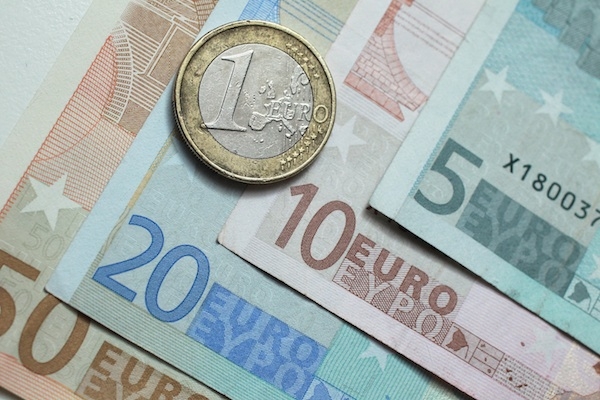All currency is faith. When the noble barman at the local pours a pint in exchange for your £5 note, he does so in the faith that the little blue note can be exchanged in turn for other goods and services. This is the basis of a ‘fiat’ currency system where the item exchanged has no intrinsic value, but is a pledge of what everyone trusts it is worth. If, however, people begin to lose faith in the thread of trust which links notes to value, the existence of that particular currency becomes troubled. The value of the currency system is called into question, its notes become worthless and eventually, hyper-inflation and chaos ensue. The euro, the legal tender for the largest economic zone in the world, is currently undergoing just such an existential crisis. The patient has already spent some hard hours on the therapist’s couch. However, like many suffering a nervous breakdown, the euro has become at good at hiding it.
If you have been told what to look for, though, it is easy to see that all is not well. In this case, the symptoms show up in a system called Target2. Briefly, Target2 is the financial plumbing that means there is (for now) no ‘Greek’ euro or ‘German’ euro, but simply the euro. It also explains how despite having no access to private capital, Spain and, in particular, Greece have continued to operate. It ensures that no individual country within the euro can run out of euros (i.e. it prevents there being a ‘run’ on any country’s individual exposure to the euro) and it is what turns an exchange rate system into a genuine monetary union allowing the free flow of goods, labour and capital across the zone. So far, so good.
However, as we all know, some &”Eurozone” countries are more equal than others. Nervous depositors from the PIIGS, unsure as to what their savings might become if their country departs the currency, have slowly been moving their money to German banks. Here comes the cross-eyed bit. When this happens, in order to prevent a liquidity problem, the Spanish bank borrows from the Spanish National Bank which, in turn, borrows from the ECB. This process, which does not necessarily show up in the price of the countries sovereign debt markets, has created a worryingly large imbalance at the ECB (i.e. there has been capital flight but it has taken place internally within the euro). The bottom line is that all the national central banks of the PIIGS owe the ECB, and the ECB owes Germany. A lot. So much in fact, that some lawyers in Germany are now beginning to ask if this isn’t an under-the-counter way of subsidising Europe, which would in effect make Target2 unconstitutional within Germany.
Now to the point. Is all the money owed to Germany by the PIIGS a real risk or is it just an accounting issue (as some commentators have suggested)? It certainly is an accounting issue; part of Target2’s role is to act as the ‘scorecard’ between the Eurozone central banks. However it is accounting for real cashflows and transfers of value between Eurozone countries. In extremis, where a country leaves the euro and rescinds its obligations under Target2, this represents a real loss for those countries that remain within the currency, with Germany particularly badly hit. Others argue that owing money to the ECB (or indeed any central bank that can print its own money) is a bit like owing bread to the baker. If you don’t make good, he can always bake some more for himself. This is true, but is also true of any other intra-sovereign debts, and if this provides an acceptable solution for Target2 defaults, surely it could be used to wipe out other inconvenient borrowings.
But doesn’t all this start to shift the scary existential questions away from the euro and onto the idea of ‘fiat’ currency itself? Some say that if the PIIGS walk away from the euro all the money owed to Germany could simply be re-printed either as Euro 2.0 or as new Deutsche Marks. Certainly this is true. Again, any central bank, as long as it has a mint, can print its own money. But, saying &”it’s fine, we would just print more money” seems to be quite a casual response to the issue. It took many years of fine-tuning to get the balance right on the way in to the euro. On the way out however, you could be left with several currencies scattered in the wind, trying to work out ‘who they really are’ again.
Will it get that bad? Probably not. After a few more years of therapy, the patient probably pulls himself together. Nevertheless, it would seem prudent to monitor his symptoms closely for signs of that full breakdown.
James Conway and Michael O’Connor are partners at Portman Capital a leading independent Corporate Finance house. They are the authors of The increasing significance of Target2, a research note published today by the Centre for Policy Studies.
James Conway
Broken down fiat






Comments